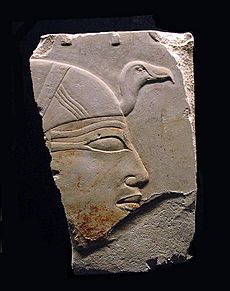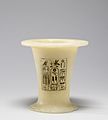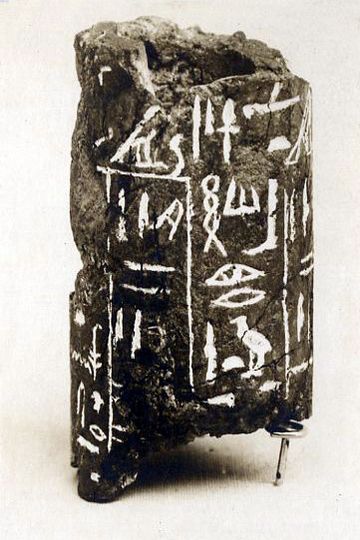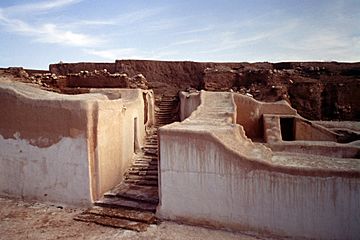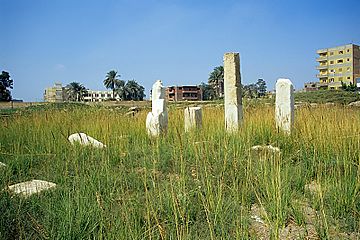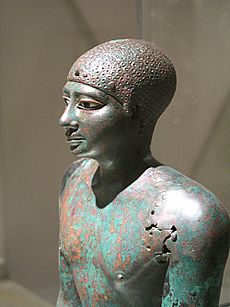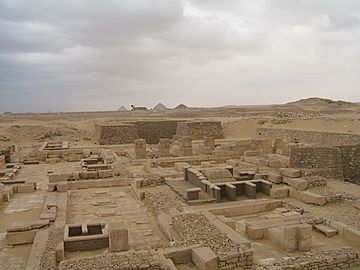Pepi I Meryre facts for kids
Quick facts for kids Pepi I Meryre |
|
|---|---|
|
|
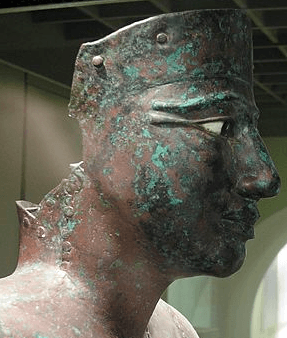
Lifesize copper statue of Pepi I, Cairo Museum
|
|
| Pharaoh | |
| Reign | Duration: over 40 years, in the second half of the 24th century BC or early 23rd century BC (6th Dynasty) |
| Coregency | uncertain, possibly with his son Merenre at the end of his reign |
| Predecessor | Userkare |
| Successor | Merenre Nemtyemsaf I |
| Consort |
|
| Children |
|
| Father | Teti |
| Mother | Iput |
| Burial | Pyramid of Pepi I in South Saqqara |
| Monuments | Pyramid complex Pepi Men-nefer, at least six pyramids for his consorts and numerous Ka-chapels |
Pepi I Meryre (also called Pepy I) was an ancient Egyptian pharaoh. He was the third king of the Sixth Dynasty of Egypt. Pepi I ruled for over 40 years around the 24th and 23rd centuries BC. This was towards the end of the Old Kingdom period.
Pepi I was the son of Teti, who started the Sixth Dynasty. Pepi became king after a short rule by Userkare. His mother was Iput, who might have been the daughter of Unas. Unas was the last ruler of the previous Fifth Dynasty. Pepi I had at least six wives. His son, Merenre Nemtyemsaf I, became king after him. Pepi I might have shared power with Merenre at the very end of his rule. Pepi II, who was also likely Pepi I's son, became king after Merenre.
Pepi I's rule had some challenges. There were troubles when he first became king. Later, he faced a plot by one of his wives. This plot might have tried to make her son the next king. Pepi I also had to deal with the pharaoh's power slowly decreasing. Local officials were becoming more powerful. Pepi I responded by building many temples for local gods. He also built many chapels for his own worship across Egypt. This helped him show his power in different areas. Egypt was rich during his time, which allowed Pepi I to build more than any other Old Kingdom king.
Pepi I also supported smaller local centers. He chose officials who were not from powerful noble families. This helped to reduce the influence of strong local families. He continued his father Teti's plan to expand a network of royal storage places. From these, taxes and workers could be easily gathered. After the plot against him, Pepi I made alliances. He married two daughters of Khui, a local governor (called a nomarch) from Abydos. Their names were Ankhesenpepi I and Ankhesenpepi II. He also made Khui's wife, Nebet, and her son, Djau, important officials called viziers.
Egypt's foreign policy under Pepi I included military trips. These trips were to Nubia, Sinai, and the southern Levant. Egyptian boats were used to land soldiers on the coast of the Levant. Trade was strong with places like Byblos, Ebla, and the oases in the Western Desert. Pepi I also sent teams to mine and quarry in Sinai and other distant places.
Pepi I built a pyramid complex for his burial in Saqqara. He also built at least six more pyramids for his wives next to his own. Pepi's pyramid was originally about 52.5 meters (172 feet) tall. It had a main temple next to it. The walls of Pepi I's burial room and other areas were covered with Pyramid Texts. These are ancient spells and writings. This was the largest collection of Pyramid Texts from the Old Kingdom. For the first time, these texts also appeared in some of his wives' pyramids.
During excavations, parts of a mummy and internal organs were found. They are thought to belong to Pepi I. Pepi's complex, called Pepi Mennefer, was used for his burial worship well into the Middle Kingdom. This name eventually became the name for the nearby capital city of Egypt, Memphis. Pepi's worship stopped early in the Second Intermediate Period. Later, during the New Kingdom and Mamluk era, his monuments were taken apart for their stone.
Contents
Family Life
Parents of Pepi I
Pepi I was the son of Pharaoh Teti and Queen Iput. We know this from writings found in her tomb and on a stone tablet. Iput's tomb was changed from a simple mastaba (a flat-topped tomb) into a pyramid when Pepi became king. This shows her importance as the king's mother.
Iput might have been the daughter of Unas, the last pharaoh of the Fifth Dynasty. However, this is not fully certain. She likely passed away before Pepi became pharaoh. Teti was Pepi's father because Iput's tomb was built next to Teti's pyramid, which was common for a queen.
Wives of Pepi I
Historians have identified six wives of Pepi I. His most well-known wives were Ankhesenpepi I and Ankhesenpepi II. Both of them had sons who would become pharaohs. They were the daughters of Khui, the nomarch (governor) of Abydos, and his wife Nebet.
Other wives included Nubwenet, Inenek-Inti, and Mehaa (also called Haaheru). All these queens were buried in pyramids next to Pepi's own pyramid. Another wife, Sebwetet, is mentioned on stone pieces found near Pepi's pyramid.
Two more women, Nedjeftet and Behenu, might also have been Pepi I's wives. Nedjeftet's name was found on blocks near Pepi's pyramid, but it's not clear if she was his wife. Behenu was buried in the second largest queen's pyramid in Pepi's burial area. She could have been a wife of Pepi I or even Pepi II.
There was also an unnamed wife, known only by her title "Weret-Yamtes" (meaning "great of affection"). She was involved in a plot against Pepi I. This is known from the tomb writings of Weni, an official who served Pepi. Weni did not write her name on purpose.
Children of Pepi I
Pepi I had at least four sons. Merenre Nemtyemsaf I was likely his son with Ankhesenpepi I. Pepi II Neferkare was the son of Ankhesenpepi II. Pepi II was probably born late in Pepi I's rule, as he was only six years old when he became king after Merenre. Some historians think Pepi II might have been Merenre's son instead.
Another son was Teti-ankh, whose mother is unknown. He is mentioned in an inscription found in Pepi's pyramid. Prince Hornetjerkhet, another son of Pepi I, was buried near his father's pyramid. His mother was Mehaa.
At least three of Pepi I's daughters have been identified. They all became wives of Pepi II. The first was Meritites IV, the king's oldest daughter. She was buried near her father's pyramid. The second was Neith, whose mother was Ankhesenpepi I. The third was Iput II, but it's not fully certain if she was Pepi I's daughter.
Time as King
When Pepi I Ruled
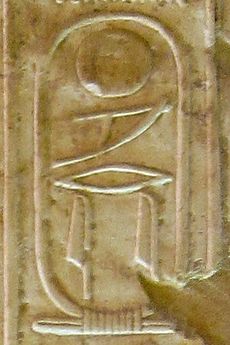
We know Pepi I became king after Userkare and was followed by Merenre I. Ancient records like the South Saqqara Stone and the Abydos King List confirm this order. The South Saqqara Stone, written during Pepi II's time, shows the kings as "Teti → Userkare → Pepi I → Merenre I".
Some older writings, like those by Manetho, do not mention Userkare. They show Pepi I directly following Teti. However, most historical and archaeological evidence supports Userkare ruling briefly between Teti and Pepi I.
How Long Pepi I Ruled
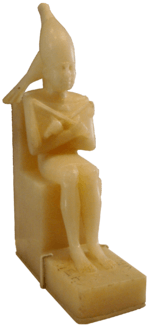
Pepi I ruled Egypt for over 40 years. Some experts believe it was as long as 49 or 50 years. In the Old Kingdom, years were counted by "cattle counts." These counts happened every two years to figure out taxes.
The South Saqqara Stone mentions the 25th cattle count during Pepi I's rule. This suggests he ruled for 49 years. Manetho's writings also say Pepi I ruled for 53 years.
Pepi I's many building projects and objects celebrating his first Sed festival also show he ruled for a long time. The Sed festival was a special event held after 30 years of a king's rule to renew his power. Many jars and vessels celebrating Pepi's first Sed festival have been found. They have inscriptions like "The king of Upper and Lower Egypt Meryre, may he be given life for ever. The first occasion of the Sed festival."
The Sed festival was very important for Old Kingdom kings. Even if a king didn't celebrate it, pictures of it were often put in temples. Pepi I's government often mentioned his first jubilee for years after it happened. This shows how important it was.
Politics and Power
Becoming King
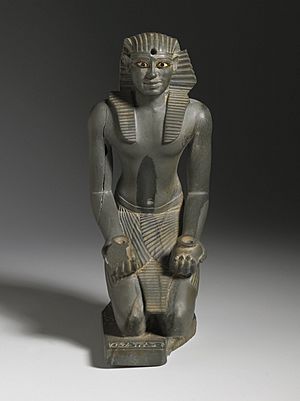
Pepi I's journey to the throne might have been difficult. Some ancient writings suggest his father, Teti, faced a plot. During Teti's rule, the number of guards at the palace increased. Also, the names of some palace officials were erased from their tombs. This might have been an attempt to remove their memory because they were involved in the plot.
Pepi I did not become king right after his father. Instead, King Userkare ruled for a short time. Userkare's role is unclear. He might have been a temporary ruler until Pepi I was old enough. However, some historians think Userkare might have taken power briefly. This is because Userkare used full royal titles. Also, many officials who served both Teti and Pepi I did not mention Userkare in their tomb writings. This suggests he was not seen as a rightful king.
Pepi I chose the Horus name of Mery-tawy, meaning "Beloved of the Two Lands." This name might show that he wanted peace after a time of trouble. He also changed his throne name to Meryre, meaning "Beloved of Ra." This change might show an agreement with the powerful priests of the sun god Ra.
Changes in Government
During Pepi I's reign, the Egyptian government became less centralized. Powerful families in the provinces (regions) gained more influence. They even married into the royal family. This slowly weakened the king's power.
Pepi I tried to stop this by changing how the government worked. He appointed many new governors, especially in Upper Egypt. He also built royal Ka-chapels (small worship buildings) all over Egypt. This helped to strengthen the king's presence in the provinces. These building projects show that Egypt was rich during Pepi's time.
Pepi I also chose senior officials who were not from noble families. This helped to reduce the power of strong regional families. Important officials were often moved to different jobs. This might have been a way to prevent anyone from gaining too much power.
Plot Against the King

At some point, Pepi I faced a plot by one of his wives. She is only known by her title "Weret-Yamtes." Weni, an official who served as a judge in the trial, did not write down her exact crime. This event shows that even the king was not completely safe. Most historians believe this plot happened after Pepi I had ruled for more than 20 years.
Perhaps because of this plot, Pepi I married two daughters of Khui, the governor of Abydos. This might have been a way to gain the loyalty of a powerful family. It also shows that family ties were very important in government during the Sixth Dynasty.
For the first time in a very long time, a woman held the title of vizier (a high official). This was Khui's wife, Nebet. Later, their son Djau also became a vizier. These marriages might have led to the temple of Min in Coptos (Khui's home) becoming very important to the royal family.
Military Actions
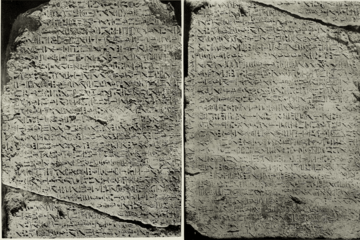
Pepi I's reign saw many military trips into Nubia. This is known from tomb writings of local governors and objects found in Nubia. The royal records also mention at least one campaign into Nubia. These campaigns involved sending messengers, fighting, and bringing back goods and people to Egypt.
Pepi I also sent at least five military expeditions to the "sand dwellers" in Sinai and southern Canaan. These campaigns are described in the tomb of Weni, who was a palace superintendent but acted like a general. Weni said he gathered tens of thousands of men from different parts of Egypt. Nubian soldiers were also hired. This shows that Egypt did not have a permanent army at that time.
The goal of these campaigns was likely to fight against local people or to take their land and goods in southern Canaan. Egyptian troops landed on the coast using transport boats. Weni reported that walled towns were destroyed, trees were cut down, and local shrines were burned.
Economy and Trade
Pepi I's reign was a peak time for Egypt's foreign policy. Trade was strong, and there were many mining and quarrying trips.
Trade and Mining
Trade with places along the Levantine coast was very active under Pepi I and Pepi II. Byblos was a main trading partner. Many stone vessels with Pepi's name have been found there. Through Byblos, Egypt also had contact with the city of Ebla in modern-day Syria. Vessels with Pepi's name were found near Ebla's royal palace.
Mining trips for turquoise and copper continued in Wadi Maghareh, Sinai. These trips likely started from the Red Sea port of Ayn Soukhna. This port might also have been used for trips to the southern Red Sea, possibly to Punt. Alabaster was extracted from Hatnub, and stone for building came from Wadi Hammamat. There were also trade routes across Egypt's Western Desert to various oases.
Domestic Policies
Pepi I changed how agricultural lands were managed. New administrative centers called ḥwt were created. These centers controlled land, animals, and workers. Along with temples and royal lands, these ḥwt formed a network of storage places. From these, royal officials could easily collect taxes and workers.
Pepi I also issued decrees that made some institutions free from taxes. For example, he gave a tax exemption to a chapel for his mother in Coptos. Another decree freed people serving in the pyramid towns of Sneferu from palace work or forced labor. Some historians see these exemptions as a sign of corruption. They also believe these exemptions weakened the state over time.
Other activities related to farming and the economy are known from tomb inscriptions. An official named Nekhebu oversaw the digging of canals in Lower Egypt and Middle Egypt.
Building Projects
Pepi I built many structures across Egypt. He left more monuments than any other ruler before the Twelfth Dynasty. His rule is seen as a high point of the Old Kingdom because of all the building, government changes, trade, and military actions. Pepi I focused on building for local worship and royal Ka-chapels. This helped to show the king's power in the provinces.
Ka-chapels
Ka-chapels were small buildings for worship. They held offerings for the Ka (life force) of the king. Pepi I's Ka-chapels were found or known to exist in places like Hierakonpolis, Abydos, Memphis, and other areas. These chapels were likely part of larger temples. This shows the king's direct control over the temples' activities.
In Hierakonpolis, under Pepi's Ka-chapel, two copper statues were found. They were made by hammering copper plates over wood. They were taken apart and placed inside each other. The outer statue had Pepi I's name and titles. The statues showed Egypt's enemies being "trampled." The larger statue is Pepi I. The smaller one is thought to be his son Merenre. This might show the transfer of power from father to son. Another idea is that the smaller statue shows a younger Pepi I, renewed by the Sed festival.
Temples
Pepi I's building efforts also included temples for gods. In Bubastis, he built a large wall with a small Ka-chapel inside. This was next to the main temple for the goddess Bastet.
In Dendera, Pepi I restored the temple complex for the goddess Hathor. He often called himself "son of Hathor of Dendera" on vessels. In Abydos, he built a small chapel for the local god Khenti-Amentiu. He also called himself the son of Atum of Heliopolis. This shows the growing importance of these gods' worship.
In Elephantine, plaques with Pepi's name were found in the temple of Satet. This suggests royal interest in the local worship there. Pepi built a red granite shrine (naos) in this temple. It might have held a statue of the goddess or Pepi I himself. Pepi I's name is on the shrine, calling him "beloved of Satet." Pepi I and Pepi II were the first kings to build small stone temples for local gods.
Pyramid Complex
Pepi I built a pyramid complex for himself in South Saqqara. He named it Men-nefer-Pepi, meaning "Pepi's splendor is enduring." This shortened name, Mennefer, eventually became the name of the nearby capital city, Memphis. Next to Pepi I's complex, a burial ground was built for his wives and high officials.
Main Pyramid
Pepi's main pyramid was built like other royal pyramids of that time. It had a core of limestone blocks covered with finer blocks. The pyramid is now destroyed, but it was once about 52.5 meters (172 feet) tall.
Inside the pyramid, a passage led to three rooms: an antechamber, a serdab (a sealed room for a statue), and a burial chamber. The burial chamber held the king's sarcophagus (stone coffin). A pink granite chest for internal organs (canopic chest) was found undisturbed. Fragments of a mummy and linen wrappings were also found, believed to be Pepi I's.
The walls of the antechamber, burial chamber, and passage were covered with Pyramid Texts. These hieroglyphs were painted green, symbolizing new life. Pepi I's pyramid has the largest collection of Pyramid Texts from the Old Kingdom. These texts were meant to help the king's soul (ba and Ka) reunite and live forever among the gods.
Mortuary Temple
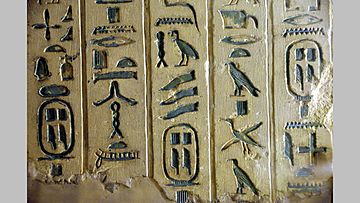
Pepi's pyramid was part of a larger complex. This included a small cult pyramid and a mortuary temple. The cult pyramid was symbolic and might have held the king's Ka or a small statue. It was used for rituals.
A valley temple by the Nile and a causeway (raised road) led to the pyramid. The main temple, next to the pyramid, had an entrance hall, an open courtyard with columns, and storage rooms. It also had a chapel with five statue niches and an offering hall. Both the temple and causeway are now heavily damaged because people in later times took their stones for building materials.
Pepi I's Burial Ground
Pepi's pyramid complex was the center of a larger burial ground. This area included tombs for the royal family and high officials. Pepi built pyramids for his wives to the south and southwest of his own pyramid. These were outside his main complex but within a special area. Three main queens' pyramids were built in a row, from east to west.
Pyramid of Nebwenet
The easternmost pyramid belonged to Queen Nebwenet. Her name and titles were found on a stone piece in her temple. Her pyramid had a base of about 26.2 meters (86 feet). Inside, a passage led to an antechamber and burial chamber. Fragments of a sarcophagus were found there.
Pyramid of Inenek-Inti
West of Nebwenet's pyramid was the pyramid of Inenek-Inti. Her name and titles were on stones at the entrance to her temple. Her pyramid was similar in size and layout to Nebwenet's. Fragments of a sarcophagus were found inside. Inenek's temple was larger than Nebwenet's and included a small cult pyramid.
Queen of the West
West of Inenek's pyramid was the "Queen of the West." Her identity is known only as "the eldest daughter of the king" from an obelisk. Her pyramid was about 20 meters (66 feet) at its base. Many burial items were found inside, but none had her name. Her temple was built quickly and had an offering hall.
Pyramid of Ankhesenpepi II
The pyramid of Ankhesenpepi II was the largest of the queens' pyramids, about 31.4 meters (103 feet) at its base. Her burial complex was also the largest after Pepi's. It included a temple and 20 storage rooms. The entrance had a large granite frame with her name and titles.
Her burial chamber walls were covered with Pyramid Texts. This was special because usually only kings had these texts. Fragments of a black basalt sarcophagus were found there.
Pyramid of Behenu
Queen Behenu's pyramid was similar in size to the other queens' pyramids. It was on the western side of the burial ground. Her temple was on the south side of her pyramid. The burial chamber had many Pyramid Texts. The head of a wooden statue of the queen and her basalt sarcophagus were found there.
Pyramid of Mehaa
Pepi's wife Mehaa was buried in a pyramid near Pepi's complex. Her temple was next to her pyramid. A relief with the name and image of her son, Prince Hornetjerykhet, was found there. Behenu's pyramid was built into Mehaa's, meaning Mehaa was a wife earlier in Pepi's reign, and Behenu lived later.
Legacy of Pepi I
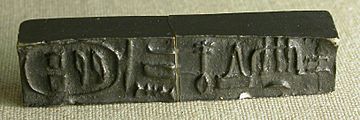
Old and Middle Kingdoms
After his death, Pepi I was honored with a special burial worship. This continued in his complex until the Middle Kingdom. This means his worship was still celebrated even during the First Intermediate Period, when the Egyptian government seemed to have broken down.
Many royal family members and high officials were buried near Pepi's pyramid. This included his wives Ankhesenpepi II and III, and his daughter Meritites. Starting with Pepi II's rule, common people also began to be buried in the area. They also showed devotion to Pepi I and his wives.
The conquest of Egypt by Mentuhotep II stopped activities at the burial ground. But they started again later in the Eleventh Dynasty. Pepi's royal worship was renewed, but on a smaller scale. Private burials stopped in the wider area and focused on Pepi's temple. New tombs were built in abandoned parts of the complex. Pepi I's royal worship seems to have ended when the Second Intermediate Period began.
New Kingdom
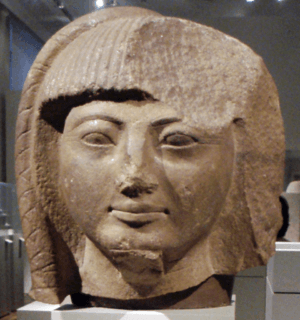
During the New Kingdom, new private burials happened in Pepi's burial ground. Some rooms in his temple were even used as catacombs (underground burial places). The people buried there were often from lower social classes.
The Karnak king list, made during the rule of Thutmosis III, honored certain royal ancestors. Pepi I and other kings were listed by their birth names. This might be because popular worship for these kings continued into the New Kingdom, using their birth names.
Later, during the rule of Ramses II, Prince Khaemweset restored some Old Kingdom monuments. Pepi's pyramid complex was among them. Khaemweset wrote that he found the pyramid "abandoned." This shows that Pepi's burial worship had stopped by then.
Later Periods
Stone quarrying (taking stone for building) became widespread during the Late Period of Egypt. This affected Pepi's burial ground. However, burials still continued sometimes. Both stone robbing and burials stopped at some point. The burial ground was then abandoned until the Mamluk period, when intense stone quarrying started again.
|
See also
 In Spanish: Meryra Pepy para niños
In Spanish: Meryra Pepy para niños


